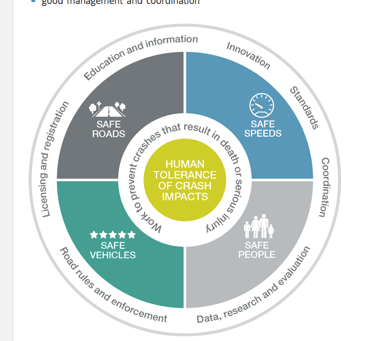Around 1,200 people die on Australian roads each year and 800 are seriously injured each week. Towards Zero recognises there’s no acceptable level of death or injury on the roads. Yet the annual road toll has fallen only 13% since 2010, well short of the National Road Safety Strategy 2020 target of at least 30% drop.
Cause of death
Deaths and injuries on the roads are not just an Australian problem. Road injuries are the ninth leading cause of death globally and the main cause of death among 15-29 year olds.
OECD figures for 2016 show the three countries with the highest deaths per 100,000 population are Chile, US and Korea. The lowest deaths per 100,000 are in Switzerland, the UK and Sweden. Australia falls in the middle, with more deaths than fast-driving Germany, Spain or the UK.
Safe systems
The current worldwide approach to road safety is “safe systems”. This basically means achieving safe roads, safe vehicles, safe speeds, safe people through education, rules and enforcement, licensing and registration.
The “safe systems” roads safety strategy isolates the road transport system from the rest of life and breaks everything down into parts, eg, road users, vehicles, roads. Then it tries to improve the performance of each part and puts them back together for a better result. This approach may be too limited.
Driving is part of life
When people drive, they are affected by what is going on in their own lives and at work. Wider societal problems, like unemployment, money problems or divorce, also affect their driving. Focusing only on road user behaviour ignores the underlying problems that affected it in the first place.
For example, the current system takes drug-affected drivers off the road, but does nothing about the underlying problem of addiction. Second, people increasingly have to stay connected through mobile phones so is it any surprise when it leads to distraction and inattention while driving?
Roderick McClure, University of New England, says we need to adopt a wider systems-thinking approach. This is where each area of concern – public health, workplace safety, urban planning and road safety – takes a coordinated approach to the problem of road trauma. It makes a lot of sense, though change of this nature would be a massive task.
Some declines
BITRE figures for 12 months ending July 2017 show declines in road deaths and the rate of deaths per 100,000 of the population:
• 1,235 road deaths, 3.6% lower than year ending July 2016
• 5.1 annual deaths per 100,000, 5% lower than year ending July 2016.
We could perhaps do more to recognise when there are declines, even if campaign targets have not been met. Some efforts to reduce road trauma are successful. Is it possible people are becoming immune to bad news about road safety, and feel increasingly helpless in the face of it?
Finally, our targets are very ambitious. But we may also need to change our overall approach to road trauma.


your opinion matters: